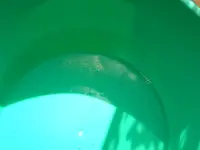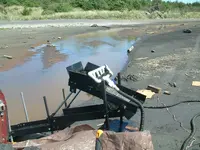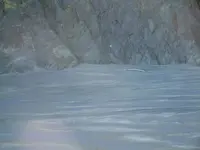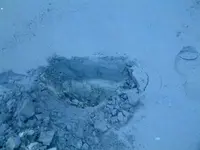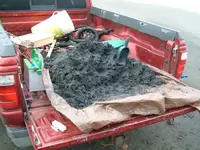Your toughest problem will be producing a reasonably workable amount of gold concentrates. Have you given any thought as to what you are going to use to do this? A gold pan for beach sand concentration is the most un-productive way to run volumes of beach sand* and if you have some type of sluice you will save yourself a lot of time and effort. After concentration a sieve/classifier set (30, 50 and 100 Mesh is my recommendation for beach sands) and a gold pan is probably your best solution to collect the gold contained. Classify your concentrates and pan each screen size separately. Gold is a little more than three times as heavy as pyrites or black sands of equal size and will separate pretty easily, with proper panning technique, when it is approximately the same size as everything else in the pan. It is best to pan the smaller mesh sized concentrates in small quantities even down to a tablespoonful at a time for the minus 100 mesh.
Good luck
*You can do it but it will take forever to run a cubic meter!
All true there!
Constructing a small sluice or fluid bed, and a small miller table would be useful to speed things up.
I'm partial to fluid beds as they can be pretty compact even for a recirculator. With my model 4, I've run recirculating with the bed resting on a 2 gallon bucket pouring tailings into another bucket sitting in a 6 gallon mixing tray to hold the water. That's about the smallest footprint for recirculating. With a bed like this, you will have to classify the material to remove the pea gravel, usually to window screen. For every bucket of material run, you will need a bucket of water. The bed will give about a gallon of concentrates per cleanout. You can do about 24x 6 gallon buckets a day if you have to classify everything first. Power for the system is a marine/deep cycle 12V battery and a 800 gph bilge pump. There seems to be a specific size range that this system cannot catch very well. It appears that, that gold is too big to weasel it's way down between the black sand grains, and too light to brute force it's way down. Coarser light material (pea gravel) may also contribute to this loss. 80 mesh should catch with no problem. These beds are simpler to operate, as they're less sensitive to angle than a sluice. Roughly level to a slight down pitch on the tailings spout is good enough.
Model 4 (14"x6"x2.5" bed, 22" overall)
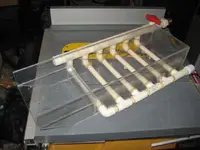
Mounted to 40 gal stock tank and solar panels.
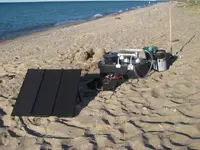
A miller table will help you to get your gold clean and in the vial much faster than panning. The main table I have is a 14"x10" work surface. The green mat is the back side of a hobby cutting mat. I did scuff the mat with 400 grit sandpaper to give better holding ability. Other surfaces can also be used, like shelf liner, chalkboard paint, and slate. My table is also equipped with a hole to move the gold into a vial. At the head of the table is the spraybar followed by the dam. Behind the dam, I put in some Scotchbrite pad and humidifier belt to help smooth and prevent bubbles. The dam smoothes the water out, and also regulates depth. I made the dam adjustable for both height and angle. The recirculating tank is a Rubbermade bin, and I built the top of the table table to fit into the handle. The cross bar also ties into the bin with 2 long screws to adjust for side to side angle and table pitch. Water is supplied with a 120V 180 gph fountain pump. For brushes I use white nylon artists brushes. I also added some LED gooseneck lights. For applying cons to the table, I use a cone nose applicator bottle with the tip cut off. The losses on this table depend on the shape of your gold. Wire gold will just keep rolling, and foil can catch in the current and fly off. I like to run flat enough to have black sand catch at the bottom of the table. It keeps the gold pretty much where placed on the table.
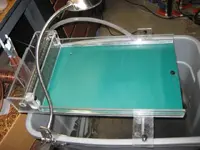
I'm in the process of building a mini table that's 9"x6". It's running a blue/black gasket material, and I built a sluice mat (vinyl runner) for it as well. It's an experiment with the mats. Hopefully, I'll get her finished today. Just have to finish the dam, and hook up the water.
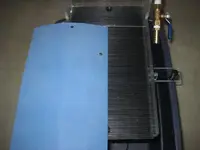
 , but i really new to prospecting so i have some questions. I know that the gold mesh is around 80 so would be pretty visible to the naked eye right?
, but i really new to prospecting so i have some questions. I know that the gold mesh is around 80 so would be pretty visible to the naked eye right? 
 , but i really new to prospecting so i have some questions. I know that the gold mesh is around 80 so would be pretty visible to the naked eye right?
, but i really new to prospecting so i have some questions. I know that the gold mesh is around 80 so would be pretty visible to the naked eye right? 



 .
.



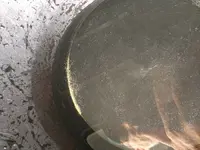
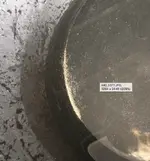
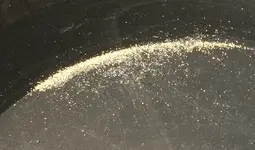
 this picture is probably equal to 1/4 of a shovel load from your beach.
this picture is probably equal to 1/4 of a shovel load from your beach.